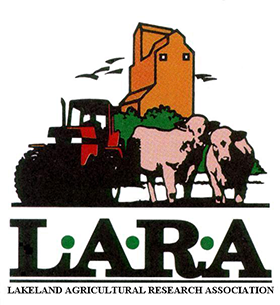Western Forage Variety Testing System
Partners:
- Alberta Agriculture and Rural Development
- Agriculture and Agri-Foods Canada
Objectives:
- To obtain agronomic information on new forage varieties and compare with approved check varieties.
- To coordinate research with other parts of Alberta, Saskatchewan and Manitoba to provide sufficient data for consideration of variety registration.
Trial Information:
The Western Forage Variety Testing System (WFTEST) was developed in 1994 as a way to coordinate the research and testing required for registration of forage cultivars across Alberta, Saskatchewan and Manitoba. LARA has been involved with AARD regional forage trials since 1991 and entered the WFTEST in 1995.
Locations across Alberta representing different soil and agronomic zones are used in the WFTEST. The LARA plots are located at Fort Kent and represent area 4. Data is collected throughout the year and sent to AARD for analysis.
Method:
In 2012, a block of plots were established at the LARA farm in Fort Kent. Alfalfa (9 varieties) plots were seeded on July 17, 2012. Meadow Brome (2 varieties), Tall Fescue (2 varieties), Timothy (3 varieties), Orchard Grass (2 varieties) and Hybrid Brome (2 varieties) were established on June 26, 2012. The plots were seeded using the LARA five-row Fabro zero-till drill in a complete randomized block design to an area of 1.15m by 6m per plot. The legume plots were inoculated and seeded with 50 lbs/ac of 11-52-0-0 and the grass plots were seeded with the recommended rate of 32-11-7-0. All plots were seeded to a depth of 0.5-0.75” except Meadow Brome and Smooth Brome which were seeded to a depth of 1”.
No harvest data was collected in the establishment year of both trials. There were some weed issues in the legume plots with broad-leaf weeds (white cockle, Narrow-leafed hawksbeard). The plots were hand weeded once in 2013.
The plots were harvested using the LARA alfalfa-Omega self-propelled forage harvester. A second cut was taken on the alfalfa trials in mid-August. Plot weight was recorded and a sample was taken to determine dry-matter content. Fresh samples were also taken from each variety, frozen and sent to A & L Canada Laboratories for wet chemistry analysis. Statistical analysis was done using ARM 9, p = 0.05.
Results:
This was the second year that data was collected on the plots established in 2012. The trials looked excellent in the spring with minimal winter kill occurring in the alfalfa trial. Regrowth was high after harvest on July 22, 2014.
In contrast to the results in 2013, the highest yielding Orchard Grass cultivar was OG426 by 2357 lbs/acre (Table 1). In 2013, Kay out-yielded OG426 by 1171 lbs/acre. After two years of data, OG426 yields, on average, higher than Kay.
Click here to view complete results.
To read more about Perennial Forages, click here.

